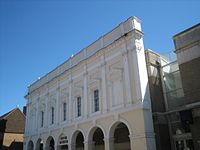 | |
 | |
| Location | Dover, England |
|---|---|
| Website | http://www.dovermuseum.co.uk/ |
Dover Museum is a museum in Dover, Kent, in south-east England.
 | |
 | |
| Location | Dover, England |
|---|---|
| Website | http://www.dovermuseum.co.uk/ |
Dover Museum is a museum in Dover, Kent, in south-east England.
Founded in February 1836 by the town's mayor Edward Pett Thompson, it was initially housed in the old Guildhall and run by the Dover Philosophical Institute. The Town Council (predecessor of Dover District Council) formally took it over 12 years later, constructing a new building to house it and the town's market, in Market Square. [1]
Shelled from France in 1942 during the Second World War, the museum lost much of its collections, including nearly all of its natural history collections. Much of the surviving material was left neglected in caves and other stores until 1946, and it is estimated only 30% of the pre-war collection survived to that date. In 1948 a 'temporary' museum was opened in the Town Hall's undercroft, but this in fact lasted until 1991, when a new museum building on three stories (behind the museum's original Victorian facade) was opened in Market Square.
On 20 July 1999 the Queen opened a new gallery on the museum's second floor centred on the Dover Bronze Age Boat. [2] In December 2000, this gallery was awarded the British Archaeological Awards ICI Award 2000, for its contribution to archaeological knowledge.
Its collections, displayed on three floors include:
The White Cliffs Experience was a visitor attraction in Dover, attached to Dover Museum. It opened in 1991 and, though it underwent a refit halfway through its life, it still did not prove a success and closed in 1999. [3] It included a Blitz Experience (an audio-visual street scene of World War II).
Only a small portion of the actual archaeology was on display, the attraction instead being reliant on dioramas and audio-visual displays. Even after one redesign, it did not prove a success and has now been closed and its building converted into the Dover Library and Discovery Centre. That portion of the archaeology can still be viewed, but only by request from the library staff. Many of the dioramas and reconstruction figures have been reused in Dover Museum.
The White Cliffs Experience was closed in 1999 for a combination of reasons; the Labour opposition group on Dover District Council had always been against the WCE, labelling it 'The White Elephant Experience' and opposing the amount of money it took to run as well as complaining that it fell short of achieving the predicted 300,000 visitors a year.
When they came to power in 1997, the new Labour council's policies for regenerating Dover relied on attracting industry and acting as an 'enabler' rather than a provider of heritage and tourism facilities. They withdrew much of the money previously paid to tourism initiatives. At the same time, the technology used to run the animatronics and shows (laser discs, carousel slide projectors and 35mm film projectors, etc.) had quickly dated and become obsolete, and by 1998 needed replacing. Various quotes were received to update the WCE but were beyond what the Council were prepared to pay, so they decided to cut their losses and close the Experience.
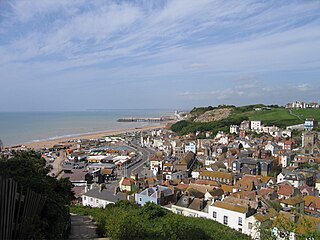
Hastings is a seaside town and borough in East Sussex on the south coast of England, 24 mi (39 km) east of Lewes and 53 mi (85 km) south east of London. The town gives its name to the Battle of Hastings, which took place 8 mi (13 km) to the north-west at Senlac Hill in 1066. It later became one of the medieval Cinque Ports. In the 19th century, it was a popular seaside resort, as the railway allowed tourists and visitors to reach the town. Today, Hastings is a fishing port with the UK's largest beach-based fishing fleet. It has an estimated population of 91,100 as of 2021.

The Science Museum is a major museum on Exhibition Road in South Kensington, London. It was founded in 1857 and is one of the city's major tourist attractions, attracting 3.3 million visitors annually in 2019.

The White Cliffs of Dover are the region of English coastline facing the Strait of Dover and France. The cliff face, which reaches a height of 350 feet (110 m), owes its striking appearance to its composition of chalk accented by streaks of black flint, deposited during the Late Cretaceous. The cliffs, on both sides of the town of Dover in Kent, stretch for eight miles (13 km). The White Cliffs of Dover form part of the North Downs. A section of coastline encompassing the cliffs was purchased by the National Trust in 2016.

Reading Museum is a museum of the history of the town of Reading, in the English county of Berkshire, and the surrounding area. It is accommodated within Reading Town Hall, and contains galleries describing the history of Reading and its related industries, a gallery of artefacts discovered during the excavations of Calleva Atrebatum, a copy of the Bayeux Tapestry, finds relating to Reading Abbey and an art collection.

The Collection is the county museum and gallery for Lincolnshire in England. It is an amalgamation of the Usher Gallery and the City and County Museum. The museum part of the enterprise is housed in a new, purpose-built building close by the Usher Gallery in the city of Lincoln.

The Royal Alberta Museum (RAM) is a museum of human and natural history in Downtown Edmonton, Alberta, Canada, located north of City Hall. The museum is the largest in western Canada with more than 7,600 square metres (82,000 sq ft) exhibition space and 38,900 square metres (419,000 sq ft) in total.
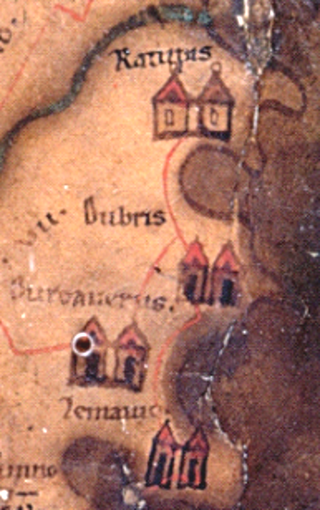
Dubris, also known as Portus Dubris and Dubrae, was a port in Roman Britain on the site of present-day Dover, Kent, England.
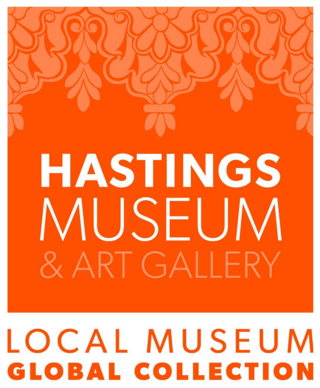
Hastings Museum & Art Gallery is a museum and art gallery located in, Hastings, East Sussex, England. Established in 1892, it originally resided in the Brassey Institute, but moved to its current location in 1927. As of 2019 it had around 97,000 objects of local history, natural sciences, fine and decorative arts, and world cultures.

The Iziko South African Museum is a South African national museum located in Cape Town. The museum was founded in 1825, the first in the country. It has been on its present site in the Company's Garden since 1897. The museum houses important African zoology, palaeontology and archaeology collections.

The Museum of Croydon is a museum located within the Croydon Clocktower arts facility in Central Croydon, England. It showcases historical and cultural artefacts relating to the London Borough of Croydon and its people. The museum is owned and run by Croydon Council.
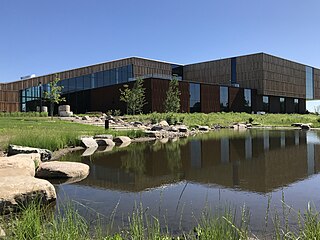
The Bell Museum, formerly known as the James Ford Bell Museum of Natural History, is located at the University of Minnesota. The museum's new location on the St. Paul campus opened in 2018. The Minnesota wildlife dioramas showcase animal specimens from around the world. The museum also houses the 120-seat digital Whitney and Elizabeth MacMillan Planetarium. The museum is part of the university's College of Food, Agricultural and Natural Resource Sciences. The museum's former location in Minneapolis is closed in January 2017.
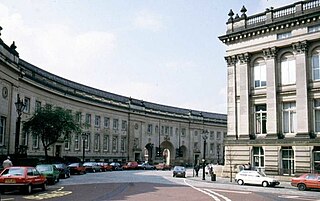
Bolton Museum is a public museum, aquarium and art gallery in the town of Bolton, England, owned by Bolton Metropolitan Borough Council. The museum is housed within the grade II listed Le Mans Crescent near Bolton Town Hall and shares its main entrance with the central library in a purpose-built civic centre. The building has good accessibility.
The History of Dover, because of the town's proximity to the Continent begins when Stone Age people crossed what was then a land bridge, before the opening up of the English Channel. Since then, successive invasions of peoples have taken place. Archaeological finds have revealed a great deal, particularly about cross channel trade and the attempts of those various inhabitants to build large-scale defences against European invaders on this part of the English coast.
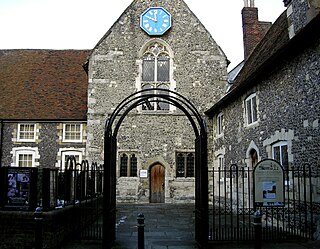
The Canterbury Heritage Museum was a museum in Stour Street, Canterbury, South East England, telling the history of the city. It was housed in the 12th-century Poor Priests' Hospital next to the River Stour. The museum exhibited the Canterbury Cross and contained a gallery dedicated to Rupert the Bear, whose creator Mary Tourtel lived in Canterbury. It held regular events and exhibitions of local and national interest. The museum closed in 2018. It has since re-opened as The Marlowe Kit; an escape room, exhibition and creative space.

The Museo Nazionale della Magna Grecia, Museo Archeologico Nazionale di Reggio Calabria or Palazzo Piacentini is a museum in Reggio Calabria, southern Italy, housing an archaeological collection from sites in Magna Graecia.

Ilkley Manor House, Ilkley, West Yorkshire, England, is a local heritage museum, art gallery, and live venue, and was established in the present building in 1961 to preserve local archaeological artefacts after the spa town expanded and much Roman material was lost. It was managed by Bradford Council Museums and Galleries department but had to be closed in 2013 owing to lack of funds. In order to keep the building open to the public, the Ilkley Manor House Trust was formed, and in April 2018, Bradford Council transferred the Manor House and three adjacent cottages to the Trust as a community asset transfer.
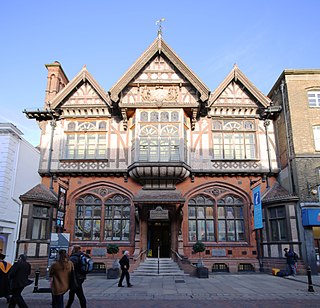
The Beaney House of Art and Knowledge is the central museum, library and art gallery of the city of Canterbury, Kent, England. It is housed in a Grade II listed building. Until it closed for refurbishment in 2009, it was known as the Beaney Institute or the Royal Museum and Art Gallery. It reopened under its new name in September 2012. The building, museum and art gallery are owned and managed by Canterbury City Council; Kent County Council is the library authority. These authorities work in partnership with stakeholders and funders.

Kingston Museum is an accredited museum in Kingston upon Thames, southwest London, England. The Scottish-American philanthropist Andrew Carnegie funded the building of the museum, which adjoins Kingston Library.

The University of Michigan Museum of Natural History is a natural history museum of the University of Michigan in Ann Arbor, Michigan, United States.